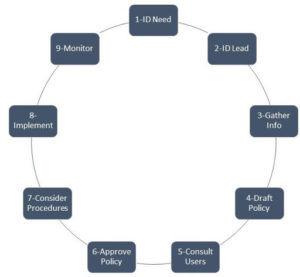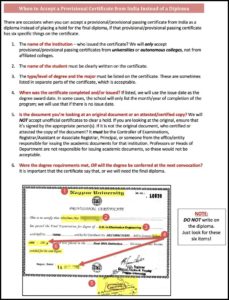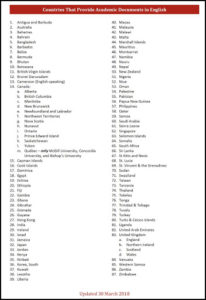Strategies in Creation and Implementation of New Policy
Much of our work is governed by policy and duties set out in procedures. The most common include the following:
- The types of credentials required
- Type of credentials for application vs. for accepted students
- From what countries you require English proficiency
- English proficiency scores required
Do you know what your policies (and the resulting procedures) are? If not, can you create one? You will need to establish both policies and procedures to help ensure that you provide clear, consistent credential evaluation. Let’s start by defining what policy and procedure means.
What is policy? A policy is a deliberate plan of action to guide decisions and achieve rational outcome(s). Is this different from a procedure? Yes, this is different. Policy is the formal guidance needed to coordinate and execute activity throughout your office or institution, whereas procedure (sometimes called operating policy or process) is the operational process(es) required to implement the policy. The table below summarizes the differences between policy and procedure:
| Policy | Procedure |
| Widespread application | Narrow application |
| Changes less frequently | Prone to change |
| Usually expressed in broad terms | Often stated in detail |
| States what and/or why | States how, when and/or who |
| Answers operational issues | Describes the process |
The following steps summarize the key stages involved in developing policies:
Figure 1: Steps to Create a Policy
The first step is to identify what need your organization may have. Policies can be developed in anticipation of and in response to need. Your organization should strive to constantly assess its activities, its responsibilities, and its environment to identify the need for policies and procedures.
Next, you need to identify who will take the lead responsibility for the policy. Then responsibility to an individual, working group, sub-committee, or to staff members, according to the expertise required.
After you determine who is responsible, it’s time to begin gathering information about your topic. You need to do this in order to determine if your understanding of the topic is accurate and up-to-date. During this stage, you should also benchmark with your peers: have they tackled this issue already? If so, what have they done to address the issue, and is that something you can adapt for your own organization? You may find that another school has a policy that may work for you, which would save you a lot of time. While researching the topic, you may want to also consider what guidance may be available from national organizations (like TAICEP, AACRAO, NAFSA, AIRC, etc.) and from accreditation bodies. You should also confirm whether there may be any statutes (state or national) which may affect your future policy.
It will help to keep the following mind map in mind when putting your policy together:
Figure 2: Policy Mind Map
Once you’ve completed your research, you will draft your policy. A very important thing to remember during this stage is that you make sure the wording, length, and complexity of the policy are all appropriate to the people who will be expected to implement it. If you must include technical jargon, remember to include definitions for these terms. Perhaps the most important aspect of drafting your policy is to allow for what I jokingly call shades of puce: leave some ambiguity for people to make decisions. That’s not to say that the policy should just let people do whatever they want, but it seems that there are simply too many instances in which people are allowed to use “that’s policy” or “zero tolerance” excuses to avoid doing the right thing. If your policy leaves a little gray so that a person can make an on-the-fly decision, that’s okay.
Now that you’ve created a draft of your policy, you need to consult with the people who will actually be affected by the policy. Think of who those people are and then ask them for their feedback. Also, discuss the potential implications of the policy on your organization as a whole and on the intended users specifically. You may need to repeat the draft and consultation steps more than once.
The sixth step is to finalize and approve the policy. Approval of the policy will depend on your organization: some organizations have a specific office/person responsible for approving policies, while others may not. For those that do not have a specific office/person, should the policy be approved by the administration, or is the committee which created the policy confident that this can be dealt with effectively by staff?
Now that your policy has been created and approved, you need to consider what procedure(s) may now be required to enforce the policy. Procedures are more likely to be required to support internal policies. Consider whether there is a need for clear guidance regarding how the policy will be implemented and by whom. Like you did with the creation of the policy, you will need to consider who is responsible for developing the procedures, by when it needs to be done, and what the processes for consultation, approval, and implementation will be. In other words, it’s very similar to creating the policy.
Once procedures needed to support the policy have been approved, it’s time to implement the policy. There are several important things to consider during this stage: is there a communication plan or a mechanism in place to release the information to your organization (and advertise it to outside people, if it affects an outside population, such as prospective students)? Is training mandatory to support the implementation of the policy and any required procedures? If so, you will need to create a timeline by which the training should be complete and a tracking mechanism (even if it’s only a spreadsheet or a checklist) to mark successful completion of the training(s) done by the required parties.
The last step is an ongoing step: monitor the implementation and use of the policy. Something you should build into the policy is a review date, a date by which you will determine how well (or not well, as the case may be) the policy is working. This can be quarterly, semi-annually, every two years, etc. – whatever you feel is appropriate for the policy, unless your organization has a mandatory timeframe for review. In addition to that, you may also wish to include a clause which states that policy can also be reviewed “as needed”; this will allow you to respond to sudden changes, changes to state and/or federal law, and accreditation body requirements, just to name a few. After that review, it may be necessary for you to make revisions to the policy.
- Sample Policy: Documents for Application versus Acceptance
Policy is often already in place, but procedures may not be. Often, it is those procedures you will need to create. In the example below, I will show how policy can lead to procedures and why flexibility in your policies and procedures is a good idea.
Cearley College has an international admissions policy: https://shelbycearley.files.wordpress.com/2018/12/Cearley-College-OP-Sample.pdf. Their policy is for both international undergraduate and graduate admissions. For graduate applicants, they require official diplomas:
Figure 3: Diploma/Degree Certificate Requirement
Notice the highlighted sentences. These two sentences allow the office some flexibility as to when diplomas must be submitted. This is important since it may take several months to years for a final degree certificate to be issued. Some countries, such as India, issue provisional certificates after a student completes the degree requirements and before the convocation of degrees. This led to a procedure regarding provisional certificates:
Figure 4: Provisional Certificate in Lieu of Diploma Procedure
Another requirement is for official English translations:
Figure 5: Official English Translation Requirement
This requirement also has some leeway built into it, and it led to two procedures. The first is a list of the countries which Cearley College knows issues official transcripts (not simply translations) in English:
Figure 6: Official English Documents Procedure
The other policy this requirement inspired relates to the types of translations it may accept in lieu of one from the institution or from an ATA-certified translator.
Figure 7: Alternates for Translations Procedure
Creating policies and procedures is time-consuming, but the long-term benefit far outweighs the initial time expense. Remember: proper preparation prevents poor performance!
References and Additional Resources
Allan, Leslie. (n.d.) Writing procedures: Tips on how to create effective documents. Retrieved from http://www.businessperform.com/articles/human-resources/writing_procedures.html
Anton, K. (2013). Process, procedure, policy: What is the difference? Retrieved from https://www.slideshare.net/comprose/what-is-a-good-process-and-procedure-system-17170920
Bizmanual. (n.d.). What are the steps to a policies and procedures manual? Retrieved from https://www.bizmanualz.com/writing-procedure-manuals/how-to-create-a-policies-procedures-manual.html
CircuitWest. (n.d.) Write your own policy and procedure manual. Retrieved from https://www.circuitwest.com.au/resource/write-your-own-policy-and-procedure-manual/
MindTools. (n.d.) Writing a procedure: Making sure things are done without mistakes and omissions. Retrieved from https://www.mindtools.com/pages/article/newTMC_78.htm
Smartsheet. (n.d.) Master writing policies, procedures, processes, and work instructions. Retrieved from https://www.smartsheet.com/company-policies-procedures
Society for Human Resource Management. (2018). How to develop and implement a new company policy. Retrieved from https://www.shrm.org/resourcesandtools/tools-and-samples/how-to-guides/pages/howtodevelopandimplementanewcompanypolicy.aspx
University of California-Santa Cruz. (1994). Guide to writing policy and procedure documents, University of California-Santa Cruz. Retrieved from https://policy.ucsc.edu/resources/images/GuidetoWritingPolicy.pdf
Weekes, J. (2017). Step-by-step: How to implement effective policies and procedures. Retrieved from https://www.healthandsafetyhandbook.com.au/step-by-step-how-to-implement-effective-policies-and-procedures/
Shelby Cearley
Senior Evaluator
Transcript Research
In this edition:
Annual Conference – March 2019 Newsletter
Member Spotlight -March 2019 Newsletter
Building a Resource Library V -March 2019 Newsletter
Establishing Policy for Your Office -March 2019 Newsletter
Education in the US -March 2019 Newsletter
Remote Work for Evaluators -March 2019 Newsletter







